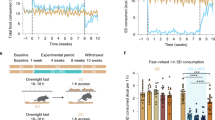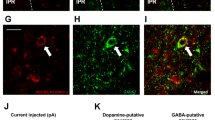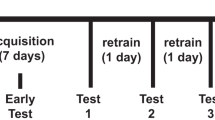Abstract
Background:
Selection of a healthy diet is the cornerstone for treating obesity and metabolic disease. Unfortunately, the majority of diets fail leading to weight regain and in some cases, pathological feeding behavior. We hypothesize that alternating bouts of caloric overconsumption and caloric restriction, behavioral manifestations of dieting induce neuroendocrine, behavioral and genetic changes that promote future bouts of palatable food intake.
Methods:
To test this hypothesis, we subjected male Long–Evans rats to a high-fat diet (HFD) feeding paradigm that induced a pattern of caloric overconsumption and caloric restriction. Under these conditions we measured operant responding for sucrose, pre-meal ghrelin secretion, the effects of peripheral ghrelin blockade on patterned feeding, HFD intake in an aversive environment and mRNA expression of the ghrelin receptor, orexin, orexin-1 and 2 receptors, and FTO in the medial prefrontal cortex, lateral hypothalamus and ventral tegmental area.
Results:
Rats subjected to this feeding regimen displayed increased ghrelin levels prior to HFD exposure and blockade of this response attenuated patterned feeding behavior. In addition, patterned feeding promoted enhanced motivation for sucrose, diminished extinction of this response and increased HFD intake in an aversive environment. The neuroendocrine and behavioral changes correlated with increased hypothalamic expression of the ghrelin receptor and FTO.
Conclusion:
Collectively, these data indicate that patterns of feeding that include caloric overconsumption and caloric restriction induce neuroendocrine and neurobiological changes that signify an enhanced drive for palatable food.
This is a preview of subscription content, access via your institution
Access options
Subscribe to this journal
Receive 12 print issues and online access
$259.00 per year
only $21.58 per issue
Buy this article
- Purchase on Springer Link
- Instant access to full article PDF
Prices may be subject to local taxes which are calculated during checkout






Similar content being viewed by others
References
Ng M, Fleming T, Robinson M, Thomson B, Graetz N, Margono C et al. Global, regional, and national prevalence of overweight and obesity in children and adults during 1980-2013: a systematic analysis for the Global Burden of Disease Study 2013. Lancet 2014; 384: 766–781.
Lim SS, Vos T, Flaxman AD, Danaei G, Shibuya K, Adair-Rohani H et al. A comparative risk assessment of burden of disease and injury attributable to 67 risk factors and risk factor clusters in 21 regions, 1990-2010: a systematic analysis for the Global Burden of Disease Study 2010. Lancet 2012; 380: 2224–2260.
Laessle RG, Tuschl RJ, Kotthaus BC, Pirke KM . A comparison of the validity of three scales for the assessment of dietary restraint. J Abnorm Psychol 1989; 98: 504–507.
National Heart Lung and Blood Institute & NI of H. Clinical guidelines on the identification, evaluation, and treatment of overweight and obesity in adults. The Evidence Report, 1998. NIH Publication No. 98-4083: Bethesda, MD, USA.
Maclean PS, Bergouignan A, Cornier M-A, Jackman MR . Biology’s response to dieting: the impetus for weight regain. Am J Physiol Regul Integr Comp Physiol 2011; 301: R581–R600.
Greenway FL . Physiological adaptations to weight loss and factors favouring weight regain. Int J Obes 2015; 39: 1188–1196.
Mathes WF, Brownley KA, Mo X, Bulik CM . The biology of binge eating. Appetite 2009; 52: 545–553.
Racine SE, Burt SA, Iacono WG, McGue M, Klump KL . Dietary restraint moderates genetic risk for binge eating. J Abnorm Psychol 2011; 120: 119–128.
Roehrig M, Masheb RM, White MA, Grilo CM . Dieting frequency in obese patients with binge eating disorder: behavioral and metabolic correlates. Obesity (Silver Spring) 2009; 17: 689–697.
Osborn RL, Forys KL, Psota TL, Sbrocco T . Yo-yo dieting in African American women: weight cycling and health. Ethn Dis 2011; 21: 274–280.
Meule A, Westenhöfer J, Kübler A . Food cravings mediate the relationship between rigid, but not flexible control of eating behavior and dieting success. Appetite 2011; 57: 582–584.
la Fleur SE, LJMJ Vanderschuren, Luijendijk MC, Kloeze BM, Tiesjema B, Adan RAH . A reciprocal interaction between food-motivated behavior and diet-induced obesity. Int J Obes 2007; 31: 1286–1294.
Stice E, Burger K, Yokum S . Caloric deprivation increases responsivity of attention and reward brain regions to intake, anticipated intake, and images of palatable foods. Neuroimage 2013; 67: 322–330.
Sharma S, Hryhorczuk C, Fulton S . Progressive-ratio responding for palatable high-fat and high-sugar food in mice. J Vis Exp 2012; 63: e3754.
Hagan MM, Chandler PC, Wauford PK, Rybak RJ, Oswald KD . The role of palatable food and hunger as trigger factors in an animal model of stress induced binge eating. Int J Eat Disord 2003; 34: 183–197.
Pankevich DE, Teegarden SL, Hedin AD, Jensen CL, Bale TL . Caloric restriction experience reprograms stress and orexigenic pathways and promotes binge eating. J Neurosci 2010; 30: 16399–16407.
Gearhardt AN, White MA, Masheb RM, Morgan PT, Crosby RD, Grilo CM . An examination of the food addiction construct in obese patients with binge eating disorder. Int J Eat Disord 2012; 45: 657–663.
Davis C, Carter JC . Compulsive overeating as an addiction disorder. A review of theory and evidence. Appetite 2009; 53: 1–8.
McGavigan AK, O’Hara HC, Amin A, Kinsey-Jones J, Spreckley E, Alamshah A et al. L-cysteine suppresses ghrelin and reduces appetite in rodents and humans. Int J Obes 2015; 39: 447–455.
Velázquez-Sánchez C, Ferragud A, Moore CF, Everitt BJ, Sabino V, Cottone P . High trait impulsivity predicts food addiction-like behavior in the rat. Neuropsychopharmacology 2014; 39: 2463–2472.
Corwin RL B-LA . Behavioral models of binge-type eating. Physiol Behav 2004; 82: 123–130.
Corwin RL, Wojnicki FHE . Binge eating in rats with limited access to vegetable shortening. Curr Protoc Neurosci 2006; Chapter 9: Unit 9. 23B.
Berner LA, Avena NM, Hoebel BG . Bingeing, self-restriction, and increased body weight in rats with limited access to a sweet-fat diet. Obesity (Silver Spring) 2008; 16: 1998–2002.
Davis JF, Melhorn SJ, Shurdak JD, Heiman JU, Tschöp MH, Clegg DJ et al. Comparison of hydrogenated vegetable shortening and nutritionally complete high-fat diet on limited access-binge behavior in rats. Physiol Behav 2007; 92: 924–930.
Sharma S, Fernandes MF, Fulton S . Adaptations in brain reward circuitry underlie palatable food cravings and anxiety induced by high-fat diet withdrawal. Int J Obes 2013; 37: 1183–1191.
Drazen DL, Vahl TP, D’Alessio DA, Seeley RJ, Woods SC . Effects of a fixed meal pattern on ghrelin secretion: evidence for a learned response independent of nutrient status. Endocrinology 2006; 147: 23–30.
Dailey MJ, Stingl KC, Moran TH . Disassociation between preprandial gut peptide release and food-anticipatory activity. Endocrinology 2012; 153: 132–142.
La Fleur SE, Kalsbeek A, Wortel J, Buijs RM . A suprachiasmatic nucleus generated rhythm in basal glucose concentrations. J Neuroendocrinol 1999; 11 : 643–652.
Merkestein M, Brans MAD, Luijendijk MCM, de Jong JW, Egecioglu E, Dickson SL et al. Ghrelin mediates anticipation to a palatable meal in rats. Obesity (Silver Spring) 2012; 20: 963–971.
Davis JF, Perello M, Choi DL, Magrisso IJ, Kirchner H, Pfluger PT et al. GOAT induced ghrelin acylation regulates hedonic feeding. Horm Behav 2012; 62: 598–604.
Skibicka KP, Hansson C, Alvarez-Crespo M, Friberg PA, Dickson SL . Ghrelin directly targets the ventral tegmental area to increase food motivation. Neuroscience 2011; 180: 129–137.
Hsu TM, Hahn JD, Konanur VR, Noble EE, Suarez AN, Thai J et al. Hippocampus ghrelin signaling mediates appetite through lateral hypothalamic orexin pathways. Elife 2015; 4. doi:10.7554/eLife.11190.
King SJ, Rodrigues T, Watts A, Murray E, Wilson A, Abizaid A . Investigation of a role for ghrelin signaling in binge-like feeding in mice under limited access to high-fat diet. Neuroscience 2016; 319: 233–245.
Holst B, Cygankiewicz A, Jensen TH, Ankersen M, Schwartz TW . High constitutive signaling of the ghrelin receptor—identification of a potent inverse agonist. Mol Endocrinol 2003; 17: 2201–2210.
Perello M, Sakata I, Birnbaum S, Chuang J-C, Osborne-Lawrence S, Rovinsky SA et al. Ghrelin increases the rewarding value of high-fat diet in an orexin-dependent manner. Biol Psychiatry 2010; 67: 880–886.
Solomon A, De Fanti BA, Martínez JA, Adachi A, Kobashi M, Andrews PL et al. The nucleus tractus solitari (NTS) participates in peripheral ghrelin glucostatic hunger signalling mediated by insulin. Neuropeptides 2006; 40: 169–175.
Faulconbridge LF, Grill HJ, Kaplan JM DD . Caudal brainstem delivery of ghrelin induces fos expression in the nucleus of the solitary tract, but not in the arcuate or paraventricular nuclei of the hypothalamus. Brain Res 2008; 1218: 151–157.
de Jong JW, Meijboom KE, LJMJ Vanderschuren, Adan RAH . Low control over palatable food intake in rats is associated with habitual behavior and relapse vulnerability: individual differences. PLoS One 2013; 8: e74645.
Yanovski SZ, Nelson JE, Dubbert BK, Spitzer RL . Association of binge eating disorder and psychiatric comorbidity in obese subjects. Am J Psychiatry 1993; 150: 1472–1479.
Colles SL, Dixon JB, O’Brien PE . Loss of control is central to psychological disturbance associated with binge eating disorder. Obesity (Silver Spring) 2008; 16: 608–614.
Gearhardt AN, White MA, Potenza MN . Binge eating disorder and food addiction. Curr Drug Abuse Rev 2011; 4: 201–207.
Kim M-S, Yoon C-Y, Park K-H, Shin C-S, Park K-S, Kim S-Y et al. Changes in ghrelin and ghrelin receptor expression according to feeding status. Neuroreport 2003; 14: 1317–1320.
Nogueiras R, Tovar S, Mitchell SE, Rayner DV, Archer ZA, Dieguez C et al. Regulation of growth hormone secretagogue receptor gene expression in the arcuate nuclei of the rat by leptin and ghrelin. Diabetes 2004; 53: 2552–2558.
Davis JF, Choi DL, Clegg DJ, Benoit SC . Signaling through the ghrelin receptor modulates hippocampal function and meal anticipation in mice. Physiol Behav 2011; 103: 39–43.
Monteleone P, Tortorella A, Castaldo E, Di Filippo C, Maj M . The Leu72Met polymorphism of the ghrelin gene is significantly associated with binge eating disorder. Psychiatr Genet 2007; 17: 13–16.
Monteleone P, Piscitelli F, Scognamiglio P, Monteleone AM, Canestrelli B, Di Marzo V et al. Hedonic eating is associated with increased peripheral levels of ghrelin and the endocannabinoid 2-arachidonoyl-glycerol in healthy humans: a pilot study. J Clin Endocrinol Metab 2012; 97: E917–E924.
Karra E, O’Daly OG, Choudhury AI, Yousseif A, Millership S, Neary MT et al. A link between FTO, ghrelin, and impaired brain food-cue responsivity. J Clin Invest 2013; 123: 3539–3551.
Davis JF, Krause EG, Melhorn SJ, Sakai RR BS . Dominant rats are natural risk takers and display increased motivation for food reward. Neuroscience 2009; 162: 23–30.
Bayard S, Langenier MC, Dauvilliers Y . Effect of psychostimulants on impulsivity and risk taking in narcolepsy with cataplexy. Sleep 2013; 36: 1335–1340.
Posey KA, Clegg DJ, Printz RL, Byun J, Morton GJ, Vivekanandan-Giri A et al. Hypothalamic proinflammatory lipid accumulation, inflammation, and insulin resistance in rats fed a high-fat diet. Am J Physiol Endocrinol Metab 2009; 296: E1003–E1012.
Acknowledgements
This work was supported by an Alcohol and Drug Abuse Research Program (ADARP) grant to JFD, ADARP JFD FY 2015.
Author information
Authors and Affiliations
Corresponding author
Ethics declarations
Competing interests
The authors declare no conflict of interest.
Rights and permissions
About this article
Cite this article
Sirohi, S., Van Cleef, A. & Davis, J. Patterned feeding induces neuroendocrine, behavioral and genetic changes that promote palatable food intake. Int J Obes 41, 412–419 (2017). https://doi.org/10.1038/ijo.2016.235
Received:
Revised:
Accepted:
Published:
Issue Date:
DOI: https://doi.org/10.1038/ijo.2016.235
This article is cited by
-
Random access to palatable food stimulates similar addiction-like responses as a fixed schedule, but only a fixed schedule elicits anticipatory activation
Scientific Reports (2019)
-
Vapor Cannabis Exposure Promotes Genetic Plasticity in the Rat Hypothalamus
Scientific Reports (2019)
-
Hyperpalatability and the Generation of Obesity: Roles of Environment, Stress Exposure and Individual Difference
Current Obesity Reports (2018)



